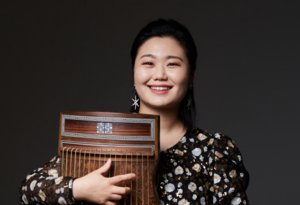
New York-based gayageum artist, jazz musician says traditional Korean music, K-pop can grow together by learning each other’s language
When K-pop artists sprinkle bits of traditional Korean instrumentation or melodies into their music, audiences often call it “fusion.” But for Kim Do-yeon, a 34-year-old gayageum player and vocalist leading a jazz quintet in New York, the term feels outdated.
“Fusion and crossover were meaningful once, but we’ve gone beyond that,” Kim said in an interview with The Korea Herald on Oct. 21. “Today, music is fluid. Genres interact all the time — but real harmony only happens when artists truly understand each other’s worlds.”
For Kim, that understanding is both technical and cultural. She points out that “gugak,” or traditional Korean music, and pop music have entirely different ways of perceiving sound and rhythm.
“In traditional Korean music, rhythm naturally accelerates or slows with emotion, while pop and jazz rely on steady beats,” she said. “Even the way we phrase melodies or interpret silence is different. Those differences are beautiful — but they also mean collaboration takes real study and listening.”
She believes that many of today’s attempts to blend K-pop and gugak remain surface-level, where the traditional instrument becomes a feature, not a voice.
“Traditional instruments have wide overtones that give them depth,” she explained. “But if you record them without knowing how to balance that sound, they end up losing their soul. To merge with pop, you need more than layering. You need a conversation.”

That belief in conversation — between traditions, genres and people — has defined Kim’s artistic path. Though she is now known for her improvisational performances that mix jazz structures with Korean tonalities, her musical beginnings were deeply personal and emotional.
Kim started playing the gayageum in the fifth grade after her dream of becoming a dancer was cut short.
“I loved Korean dance, but my parents wanted me to focus on academics,” she recalled. “When I had to stop dancing, I felt lost. The sound of the gayageum comforted me — it felt like a voice that could express what I couldn’t say.”
Her curiosity soon extended beyond tradition. After earning her degree in traditional Korean music from Seoul National University, Kim realized she wanted to challenge the limits of what the gayageum could express. With her professor’s encouragement, she moved to the US in 2014 to study at the New England Conservatory of Music in Boston, where she earned a master’s degree in contemporary improvisation, followed by a graduate diploma in jazz studies at Berklee Global Jazz Institute.
Her years abroad reshaped her musical worldview.
“Studying jazz was like learning a new language,” she said. “But I never abandoned gugak. I don’t think in terms of genres. To me, each sound is a color, and I’m just trying to paint with all the colors I know.”
That openness also informs her thoughts on K-pop. Kim enjoys the genre — not just for its global popularity, but for its sonic precision.
“If you listen to K-pop’s bass lines, you can hear how much care and money go into production,” she said. “The mixing, the balance, the groove — it’s world-class.”

Still, she rejects the idea that K-pop must find its “identity” in traditional music simply because it is Korean.
“That’s an old-fashioned way to think,” she said. “K-pop is pop first. What matters most is what kind of sound you want to create and what message you want to deliver. If traditional elements help you express that, use them — but not out of obligation.”
For Kim, the bridge between K-pop and gugak is not about defining boundaries, but dissolving them.
“Music is about absorption — ‘chaehwa,’ as we say in Korean. When two artists learn to absorb each other’s rhythm and breath, something new is born. That’s the kind of synergy I want to see,” she said
These days, Kim spends most of her time in New York, teaching and performing with her quintet. Her work continues to explore what she calls “meaningful freedom” — an improvisational space where composition, direction and storytelling coexist.
“I’m not a jazz musician or a traditional musician,” she said. “I’m just an artist trying to communicate.”
– – –
“Next Frontier” is a series examining how K-pop is incorporating elements of traditional Korean music and how gugak musicians are exploring contemporary music genres, including K-pop, in their unique music language. From expert insights to artists blending gugak and pop, the series looks into how musicians are redefining K-pop’s sound and identity. — Ed.